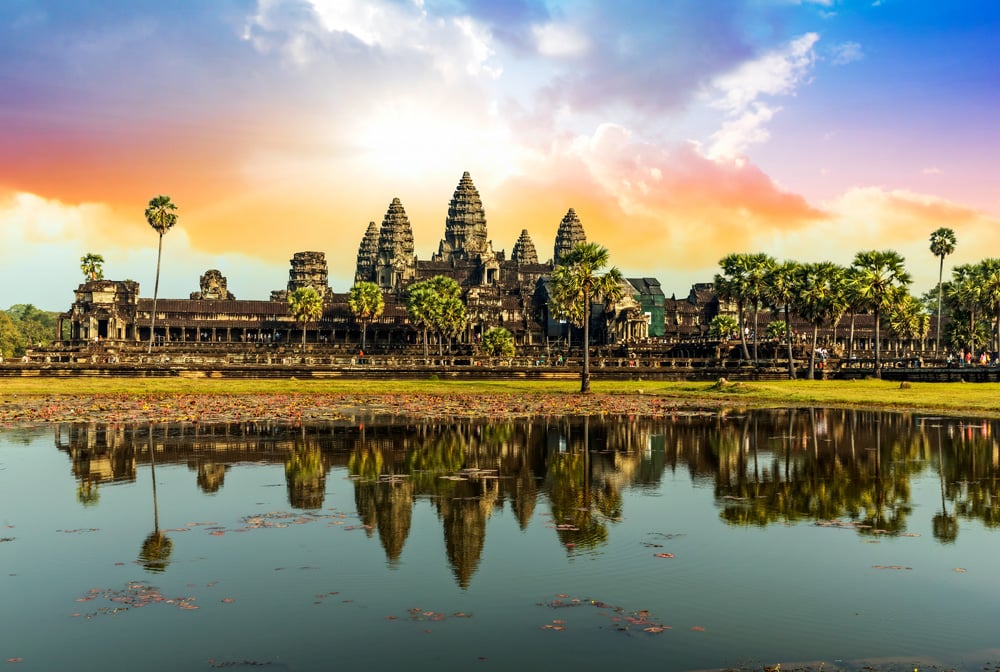Angkor Wat is a temple complex in Cambodia that was built in the 12th century by King Suryavarman II as his state temple and mausoleum. It is one of the most impressive and well-preserved examples of Khmer architecture, art, and culture, and it is also one of the most popular tourist attractions in Southeast Asia. Angkor Wat is not only a stunning architectural masterpiece, but also a symbol of the religious, political, and cultural history of Cambodia.
Angkor Wat was originally dedicated to the Hindu god Vishnu, who was considered the supreme deity by Suryavarman II and his successors. The temple was designed to represent Mount Meru, the mythical abode of the gods in Hindu cosmology. The temple complex covers an area of about 400 acres (160 hectares), surrounded by a moat and an outer wall. The main temple consists of five towers, arranged in a quincunx pattern, rising above a three-tiered pyramid. The central tower is the tallest, reaching a height of 213 feet (65 meters). The temple is oriented to the west, which is unusual for Khmer temples, and may indicate that it was intended as a funerary temple for the king.
The temple walls are decorated with elaborate bas-reliefs and sculptures, depicting scenes from Hindu mythology, such as the churning of the ocean of milk, the battle of Kurukshetra, and the judgment of Yama. The reliefs also portray scenes from the life and reign of Suryavarman II, such as his military campaigns, his royal ceremonies, and his daily activities. The reliefs are remarkable for their realism, detail, and diversity, reflecting the artistic skill and cultural sophistication of the Khmer civilization.
Angkor Wat underwent several changes and modifications over time, as different kings and dynasties ruled over Cambodia. In the late 12th century, King Jayavarman VII converted Angkor Wat into a Buddhist temple, as part of his religious reform that established Mahayana Buddhism as the state religion. He added new statues and images of Buddha and Bodhisattvas to the temple, and also built new structures nearby, such as Angkor Thom and Bayon. However, he did not destroy or alter the original Hindu features of Angkor Wat, but rather incorporated them into his Buddhist vision.
Angkor Wat remained a Buddhist shrine until the 15th century, when the Khmer empire collapsed under the pressure of Thai invasions. The capital city of Angkor was abandoned, and Angkor Wat was left to decay in the jungle. However, unlike many other Khmer temples, Angkor Wat was never completely forgotten or neglected. Some Buddhist monks continued to live and worship in the temple, and some local villagers also visited it occasionally. Angkor Wat also attracted the attention of foreign visitors and explorers, who marveled at its beauty and mystery.
In the 19th century, Angkor Wat was rediscovered by Western scholars and travelers, who recognized its historical and cultural significance. The French explorer Henri Mouhot wrote that Angkor Wat was “grander than anything left to us by Greece or Rome”. The French colonial authorities took charge of the conservation and restoration of Angkor Wat, along with other Khmer monuments. They cleared away the vegetation that had overgrown the temple, repaired some of the damaged structures, and documented some of the inscriptions and artworks. They also established an archaeological park around Angkor Wat, to protect and preserve the site for future generations.
In the 20th century, Angkor Wat faced new challenges and threats, such as war, looting, pollution, and mass tourism.
During the Vietnam War and the Khmer Rouge regime, Angkor Wat suffered some damage from bombs, bullets, and landmines. Some of its statues and sculptures were stolen or vandalized by looters and smugglers.
The increasing number of tourists also posed a risk to the temple’s stability, integrity, and authenticity. However, Angkor Wat also received new support and recognition from various sources.
In 1992, Angkor Wat was inscribed on UNESCO’s World Heritage List, as part of the Angkor Archaeological Park. This designation helped to raise awareness and funds for the conservation and management of Angkor Wat.
Several international organizations, such as UNESCO, the World Monuments Fund, and APSARA Authority, have been involved in various projects to restore, protect, and promote Angkor Wat.
Angkor Wat has also become a symbol of national pride and identity for Cambodia. It is featured on Cambodia’s national flag. It is also a source of inspiration and admiration for many artists, writers, and filmmakers.
Angkor Wat is a temple that transcends time and space. It is a testament to the glory and greatness of the Khmer civilization, and a witness to the changes and challenges of Cambodian history. It is a masterpiece of architecture and art, and a monument of religion and culture. It is a wonder of the world, and a treasure of humanity.


